MORE ABOUT MELNIK
EVENTFUL AND TURBULENT HISTORY. Time has not
consigned to oblivion the legends and facts about old Melnik. Archaeologists claim that
the Thracians were the first to settle in these parts. Later, the Romans passed through it
and left a unique trace: the ancient Roman bridge preserved to this day. It is the Slavs,
however, who are supposed to have first given the town its present name - Melnik, after
the sand pyramids (mel) which envelop the town on all sides. It became a part of
the Bulgarian state under Khan Pressiyan (836-852) and within a few centuries flourished
greatly. In the early 13th century Melnik was the capital city of the independent domain
of Lord Alexi Slav, an important and impregnable fortress and a brisk centre of arts and
crafts, of building and trade. It continued to prosper under Tzar Ivan Assen (1218-1241).
His charter for duty-free trade with the Dubrovnik merchants brought in together with
exquisite goods and artisan skills also a culture imbued with modern humanism.Melnik
became a centre where icon-painters, masters of ceramics, goldsmiths producing filigree
works, and masons who built churches and houses thrived.
The vicissitudes of history often changed the rulers of
this outlying part of the Bulgarian state. Under Byzantine domination Melnik became the
place where claimants to the Byzantine throne were exiled. They arrived with their
families and riches, built houses and supported the development of arts and trade.
The Ottoman conquest ushered in a period of several
centuries of oblivion and decline. Yet Melnik again became famous. The spark of the
Bulgarian National Revival (18th - 19th century) burst earlier into flame here than in
other parts of the country. The town regained its past splendour. It again became a major
cultural and commercial centre. In the late 17th century it emerged as a centre of church
decoration and openwork woodcarving and some time later, as a centre of the fine mural
painting. Many churches and Bulgarian schools were opened. Remarkable works of
architecture were built; theatrical performance, quadrilles and waltzes began to be played
in the parlours of eminent merchants, after Western fashions. Heavy caravans spread the
fame of Melnik wines in the distant corners od Europe. It matured in deep cellars for
several dozen years. It acquired thickness and flavour which made it much sought after in
Salonica, Athens, Vienna, France, Spain and even in Britain. Several months after the
Russo-Turkish War (1877 - 1878) the Berlin Treaty gave Melnik back to Turkey and the town
lived through the Kresna Uprising (1878). The town gradually lost its sparkle, and during
the Balkan war (1912 - 1913) which ultimately freed it, it suffered devastation by fire.
Today Melnik is an architectural reserve, a historical
town, a monument of culture. From the previously rich and prosperous town now remain what
is left of the fortress wall of Lord Slav, houses an wine cellars, churches and
monasteries. Amidst the exotic charm of the natural decor, they remind one of a romantic
tale of olden icons and carved wood, of splendid frescoes and architectural gems.
 THE NATURAL SCENERY of Melnik is truly amazing.
Impressive and austerely splendid, the Melnik pyramids rank among the most remarkable
natural phenomena in Bulgaria.
THE NATURAL SCENERY of Melnik is truly amazing.
Impressive and austerely splendid, the Melnik pyramids rank among the most remarkable
natural phenomena in Bulgaria. 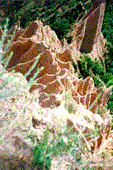 On the area of 17 sq. km (near Melnik, Rozhen i
Kurlanovo) millennia-long erosion has chiseled this unusual world. Depending on the
strength of your imagination, you could see in them obelisks, ancient towers, giant
mushrooms... etc. But the imagination of the Bulgarian master masons of the National
Revival period inspired probably by the fascinating architectural style of the Melnik
house.
On the area of 17 sq. km (near Melnik, Rozhen i
Kurlanovo) millennia-long erosion has chiseled this unusual world. Depending on the
strength of your imagination, you could see in them obelisks, ancient towers, giant
mushrooms... etc. But the imagination of the Bulgarian master masons of the National
Revival period inspired probably by the fascinating architectural style of the Melnik
house.
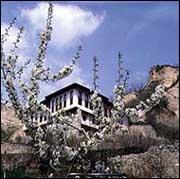 THE CHARM OF THE MELNIK HOUSE
THE CHARM OF THE MELNIK HOUSE
Its characteristic features are related to the
geographic factor. The sheer screes and the limited terrain compelled people here to fight
for every square foot of land. That is why the Melnik houses seem perched one above the
other, so close as though they are whispering something to each other. Again, to cope with
the slope, people here built the basement of stone at several levels where the thick wine
matured. Above is the storey, towering gracefully, projecting and supported by many
cantilevers. The white facades are framed with dark boards and the windows are grouped
several together in an elegant fashion. The interiors usually exhibit ceilings of carved
wood, chimney-pieces, decorative cupboards of colour woods, murals and even stained glass.
But apart from the generally typical features, every house here has an individuality of
its own, its own history and life.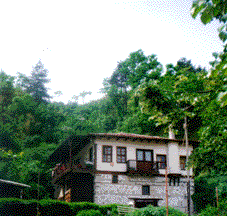
THE FEUDAL LORD'S or BYZANTINE HOUSE precedes the architecture
of the Bulgarian National Revival by several centuries. In fact it is among the earliest
civilian buildings in the Balkans and is described in Bulgarian and foreign specialist
literature. As legend has it, the castle was built for Elena-Olena, a royal relative. The
child was sent here to find a cure for a serious lung ailment.
The favourable air here helped and she recovered to marry the Russian
Prince Igor. Archaeologists have found in the building elements typical of mediaeval
Bulgarian construction and have listed it is a Bulgarian feudal fortress, probably built
in the 12th - 13th centuries. Today only the Western and the Southern outer wall are
preserved.
THE KORDOPOULOV HOUSE (1754) is a veritable gem of Bulgarian
architecture of the National Revival, remarkably planned and executed. Its basement
contains one of the largest wine cellars in the town equipped with special canals and
ventilation.
And above, the house receives the day's light from all four corners of the
world. Also there are decorative murals and stained Venetian glass, exquisite carved
ceilings and sumptuous Baroque decoration.
THE PASHA'S HOUSE was built in 1815 on the orders of the richest
Turkish bey in the Seres and Melnik region, Ibrahim Bey. But it has reverberated to the
steps of the Bulgarian revolutionary Yane Sandansky (1872-1915) who in 1912 proclaimed
freedom to Melnik. The house is elegantly and impressively planned and executed with
oriels and triangular surfaces on the roof. The wood-carved suns on the ceiling are the
work of masters from the Debur school.
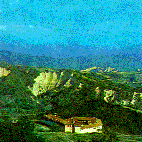 But the master-piece of the Debur school is the small internal icon stand in the
church of the ROZHEN MONASTERY.
But the master-piece of the Debur school is the small internal icon stand in the
church of the ROZHEN MONASTERY. 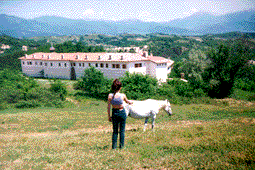 The architecture of the monastery, is very impressive. It is only 6 km from
Melnik in an easterly direction and has existed since the Second Bulgarian Kingdom in the
Middle Ages. The church in its yard, built in 1600, was renewed and painted in the 18th
century. It contains a wealth of splendid stained glass, openwork wood carvings and old
icons. Part of them, together with the wood-carvings from the icon stand were exhibited in
the Charpentier gallery, Paris and in the Huegel villa in the town of Essen.
The architecture of the monastery, is very impressive. It is only 6 km from
Melnik in an easterly direction and has existed since the Second Bulgarian Kingdom in the
Middle Ages. The church in its yard, built in 1600, was renewed and painted in the 18th
century. It contains a wealth of splendid stained glass, openwork wood carvings and old
icons. Part of them, together with the wood-carvings from the icon stand were exhibited in
the Charpentier gallery, Paris and in the Huegel villa in the town of Essen.
In Melnik one can also see the old churches St. Nicholas (13th
century), St. Nikolai, the Miracle Worker (1756), St. Peter and Paul (1840), St. Anton.
The Melnik Hotel (3 stars) is in the style of the
Melnik National Revival period and offers all facilities of up-to-date tourist services.
In the restaurant and the tavern guests can sample dishes of the Bulgarian national
cuisine and the famous natural Melnik wines.
Also available to tourists are several restored old houses.
[PAGE FOR BULGARIA]
OR
[HOME PAGE]
Comments and additional information to mmmitov@oocities.com
My URL: http://come.to/example

I got it for free at http://come.to
Copyright © 1997, 1998 Martin Mitov
The author is a member of

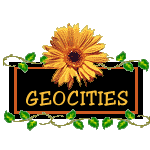
 THE NATURAL SCENERY of Melnik is truly amazing.
Impressive and austerely splendid, the Melnik pyramids rank among the most remarkable
natural phenomena in Bulgaria.
THE NATURAL SCENERY of Melnik is truly amazing.
Impressive and austerely splendid, the Melnik pyramids rank among the most remarkable
natural phenomena in Bulgaria.  On the area of 17 sq. km (near Melnik, Rozhen i
Kurlanovo) millennia-long erosion has chiseled this unusual world. Depending on the
strength of your imagination, you could see in them obelisks, ancient towers, giant
mushrooms... etc. But the imagination of the Bulgarian master masons of the National
Revival period inspired probably by the fascinating architectural style of the Melnik
house.
On the area of 17 sq. km (near Melnik, Rozhen i
Kurlanovo) millennia-long erosion has chiseled this unusual world. Depending on the
strength of your imagination, you could see in them obelisks, ancient towers, giant
mushrooms... etc. But the imagination of the Bulgarian master masons of the National
Revival period inspired probably by the fascinating architectural style of the Melnik
house.  THE CHARM OF THE MELNIK HOUSE
THE CHARM OF THE MELNIK HOUSE

 But the master-piece of the Debur school is the small internal icon stand in the
church of the ROZHEN MONASTERY.
But the master-piece of the Debur school is the small internal icon stand in the
church of the ROZHEN MONASTERY.  The architecture of the monastery, is very impressive. It is only 6 km from
Melnik in an easterly direction and has existed since the Second Bulgarian Kingdom in the
Middle Ages. The church in its yard, built in 1600, was renewed and painted in the 18th
century. It contains a wealth of splendid stained glass, openwork wood carvings and old
icons. Part of them, together with the wood-carvings from the icon stand were exhibited in
the Charpentier gallery, Paris and in the Huegel villa in the town of Essen.
The architecture of the monastery, is very impressive. It is only 6 km from
Melnik in an easterly direction and has existed since the Second Bulgarian Kingdom in the
Middle Ages. The church in its yard, built in 1600, was renewed and painted in the 18th
century. It contains a wealth of splendid stained glass, openwork wood carvings and old
icons. Part of them, together with the wood-carvings from the icon stand were exhibited in
the Charpentier gallery, Paris and in the Huegel villa in the town of Essen. 
